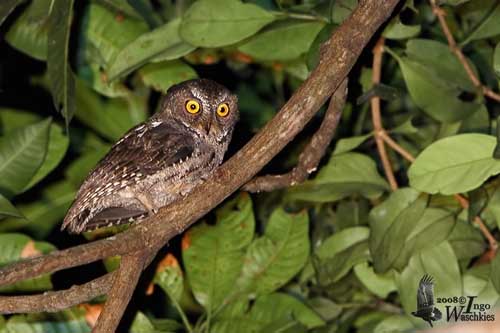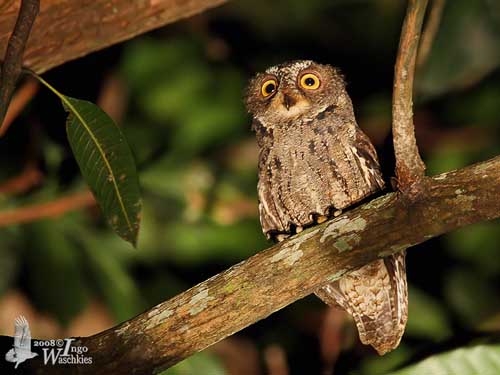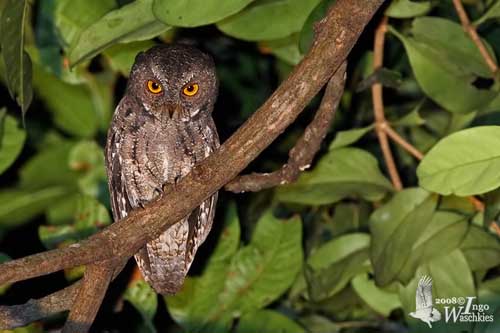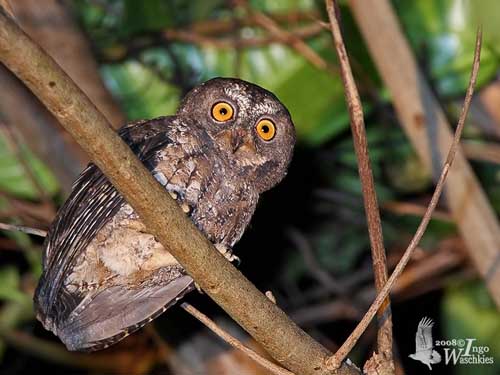
PROTECTION / THREATS / STATUS:
The Sulawesi Scops-owl appears to be widespread in Sulawesi, but as numerous forested species, it is threatened by deforestation.
However, the populations are not currently threatened.
Fr: Petit-duc de Manado
All : Manadoeule
Esp: Autillo de Célebes
Ital: Assiolo di Sulawesi
Nd: Sulawesi-dwergooruil
Sd: Sulawesidvärguv
Photographer:
Ingo Waschkies
My bird pictures on Pbase
Text by Nicole Bouglouan
Sources:
HANDBOOK OF THE BIRDS OF THE WORLD Vol 5 by Josep del Hoyo-Andrew Elliott-Jordi Sargatal - Lynx Edicions - ISBN: 8487334253
L’ENCYCLOPEDIE MONDIALE DES OISEAUX - Dr Christopher M. Perrins - BORDAS - ISBN: 2040185607
BirdLife International (BirdLife International)
XENO-CANTO – Sharing Birds sounds from around the world
Sulawesi Scops-owl
Otus manadensis
Strigiforme Order – Strigidae Family
BIOMETRICS:
Length: 19-23 cm
Weight: 83-93 g
DESCRIPTION:
The Sulawesi Scops-owl is frequently heard in the humid forests of Sulawesi. This small owl is highly nocturnal.
This species occurs in both morphs, brown and rufous, but the latter is very rare.
Male and female are similar, but the female is slightly larger than male.
The adult has brown plumage overall. The upperparts show dark-tipped white spots on scapulars. The tertial flight feathers are barred white and the tail is barred with narrow pale bars.
The upperparts are variably streaked and barred blackish-brown.
The underparts are paler with dark brown to black streaks and white spots.
On the head, the inner parts of the facial disk are whitish, and the rest varies from rufous-brown to greyish. The head is brown, finely spotted white, including the short but prominent ear-tufts.
The bill is horn-coloured to brownish. The eyes are yellow. The greyish to brownish-yellow legs are feathered. The toes and the claws are fairly weak.

The juvenile resembles adults with more heavily barred plumage on crown and mantle.
We can find five subspecies which differ in size, more or less heavy pattern and more or less feathered tarsi.
VOICE: SOUNDS BY XENO-CANTO
The Sulawesi Scops-owl’s territorial call is a clear, plaintive, ascending whistle “ploo-ek” repeated at intervals of six seconds.
We can also hear rapid, giggling, increasing notes “kik-kok-kok-kok”, and some “ooek-ooek-ooek” repeated with steady frequency, alternating with ascending whistles “oi-oi-oi”.
The female utters similar songs but slightly higher-pitched.
HABITAT:
The Sulawesi Scops-owl is resident in humid forests, clearings and edges. The species occurs from lowlands and hills up to 2500 metres of elevation. It is also found in cultivated areas with scattered trees and in scrubby areas.
RANGE:
The Sulawesi Scops-owl is found in Southern Asia, in Sulawesi and on Banggai and Sula Islands.

BEHAVIOUR:
The Sulawesi Scops-owl is a nocturnal species, becoming active at dusk. It spends the day in tree where it sleeps and rests, perched at about two metres above the ground or in the lower canopy, close to open areas such as clearings, ponds or rivers.
It feeds primarily on nocturnal insects such as moths, beetles and crickets. It hawks the flying insects from a perch.
In these Asian regions, geckos are often active and abundant at night, and the Sulawesi Scops-owl could take advantage of these easy preys. It probably feeds also on small vertebrates.
The owls of genus Otus are usually monogamous and have long-term pair-bonds. To strengthen or renew the pair-bonds, the male begins singing 3-4 weeks before the nesting period starts. Courtship feeding by male to female is also a typical behaviour in owls.

FLIGHT:
The Sulawesi Scops-owl has the typical silent flight of the Strigidae species, due to the downy feathers’ bases. The flight feathers are covered with very soft, velvety down, allowing the bird to fly silently towards the prey.
REPRODUCTION:
The breeding season usually starts before the beginning of the monsoon.
The Sulawesi Scops-owl nests in cavities such as tree holes, usually old abandoned nests excavated by woodpeckers.
The eggs are pure white as in numerous cavity-nesters. The laying is of 2-7 eggs. Incubation lasts between 15 and 35 days. The young often leave the nest before to be able to fly.
DIET:
The Sulawesi Scops-owl feeds mainly on invertebrates such as nocturnal insects, and also takes some small vertebrates and probably geckos.
This owl is active at night, and hunts from perches.
